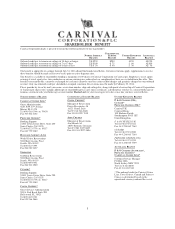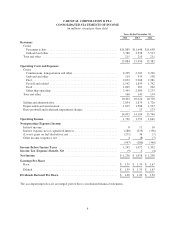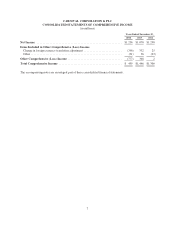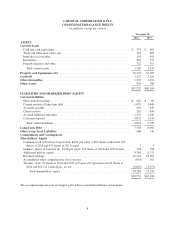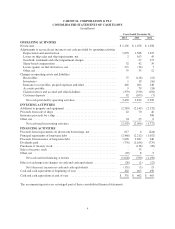Carnival Cruises 2014 Annual Report Download - page 17
Download and view the complete annual report
Please find page 17 of the 2014 Carnival Cruises annual report below. You can navigate through the pages in the report by either clicking on the pages listed below, or by using the keyword search tool below to find specific information within the annual report.Selling and Administrative Expenses
Selling expenses include a broad range of advertising, such as marketing and promotional expenses. Advertising
is charged to expense as incurred, except for media production costs. Brochures and media production costs are
recorded as prepaid expenses and charged to expense as consumed or upon the first airing of the advertisement,
respectively. Advertising expenses totaled $623 million, $588 million and $527 million in 2014, 2013 and 2012,
respectively. Administrative expenses represent the costs of our shoreside ship support, reservations and other
administrative functions, and includes salaries and related benefits, professional fees and occupancy costs, which
are typically expensed as incurred.
Foreign Currency Translations and Transactions
Each business determines its functional currency by reference to its primary economic environment. We translate
the assets and liabilities of our foreign operations that have functional currencies other than the U.S. dollar at
exchange rates in effect at the balance sheet date. Revenues and expenses of these foreign operations are
translated at weighted-average exchange rates for the period. Their equity is translated at historical rates and the
resulting foreign currency translation adjustments are included as a component of accumulated other
comprehensive income (“AOCI”), which is a separate component of shareholders’ equity. Therefore, the U.S.
dollar value of the non-equity translated items in our consolidated financial statements will fluctuate from period
to period, depending on the changing value of the U.S. dollar versus these currencies.
We execute transactions in a number of different currencies, principally the U.S. dollar, euro, sterling and
Australian dollar. Exchange rate gains and losses arising from changes in foreign currency exchange rates
between the time an expense is recorded and when it is settled as well as the remeasurement of monetary assets
and liabilities, all denominated in a currency other than the functional currency of the entity involved, are
recognized currently in nonoperating earnings, unless such monetary liabilities have been designated to act as
hedges of net investments in our foreign operations. The net gains or losses resulting from these “nonoperating
foreign currency transactions” were insignificant in 2014, 2013 and 2012. In addition, the unrealized gains or
losses on our long-term intercompany receivables denominated in a non-functional currency, which are not
expected to be repaid in the foreseeable future and are therefore considered to form part of our net investments,
are recorded as foreign currency translation adjustments, which are included as a component of AOCI.
Share-Based Compensation
We recognize compensation expense for all share-based compensation awards using the fair value method. For
time-based share awards, we recognize compensation cost ratably using the straight-line attribution method over the
expected vesting period or to the retirement eligibility date, if less than the vesting period, when vesting is not
contingent upon any future performance. For performance-based share awards, we generally recognize
compensation cost ratably using the straight-line attribution method over the expected vesting period based on the
probability of the performance condition being achieved. If all or a portion of the performance condition is not
expected to be met, the appropriate amount of previously recognized compensation expense will be reversed and
future compensation expense will be adjusted accordingly. For market-based share awards, we recognize
compensation cost ratably using the straight-line attribution method over the expected vesting period. If the target
market conditions are not expected to be met, compensation expense will still be recognized. In addition, we
estimate the amount of expected forfeitures based on historical forfeiture experience when calculating compensation
cost. If the actual forfeitures that occur are significantly different from the estimate, then we revise our estimates.
Earnings Per Share
Basic earnings per share is computed by dividing net income by the weighted-average number of shares
outstanding during each period. Diluted earnings per share is computed by dividing net income by the weighted-
average number of shares and common stock equivalents outstanding during each period. For earnings per share
purposes, Carnival Corporation common stock and Carnival plc ordinary shares are considered a single class of
shares since they have equivalent rights (see Note 3).
15


